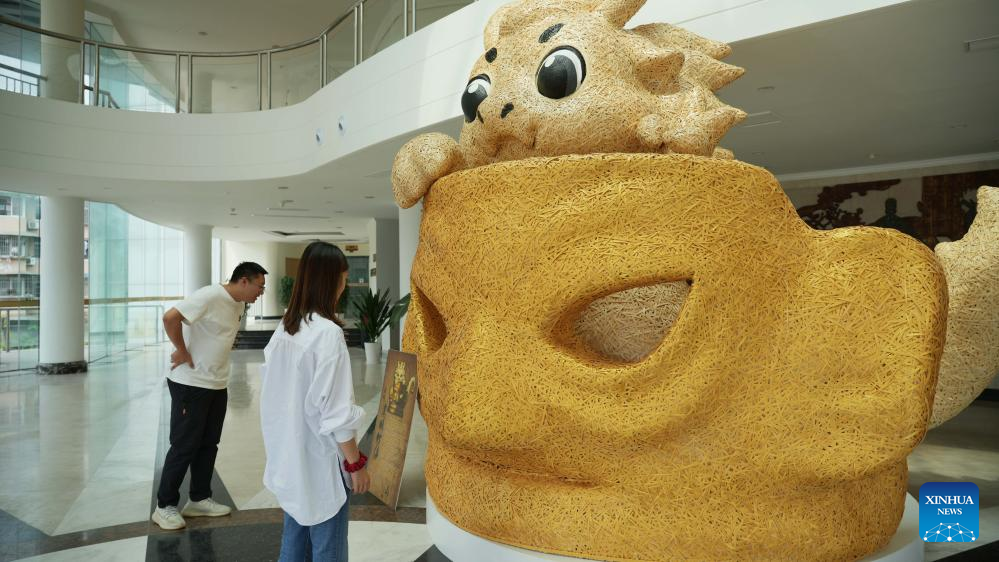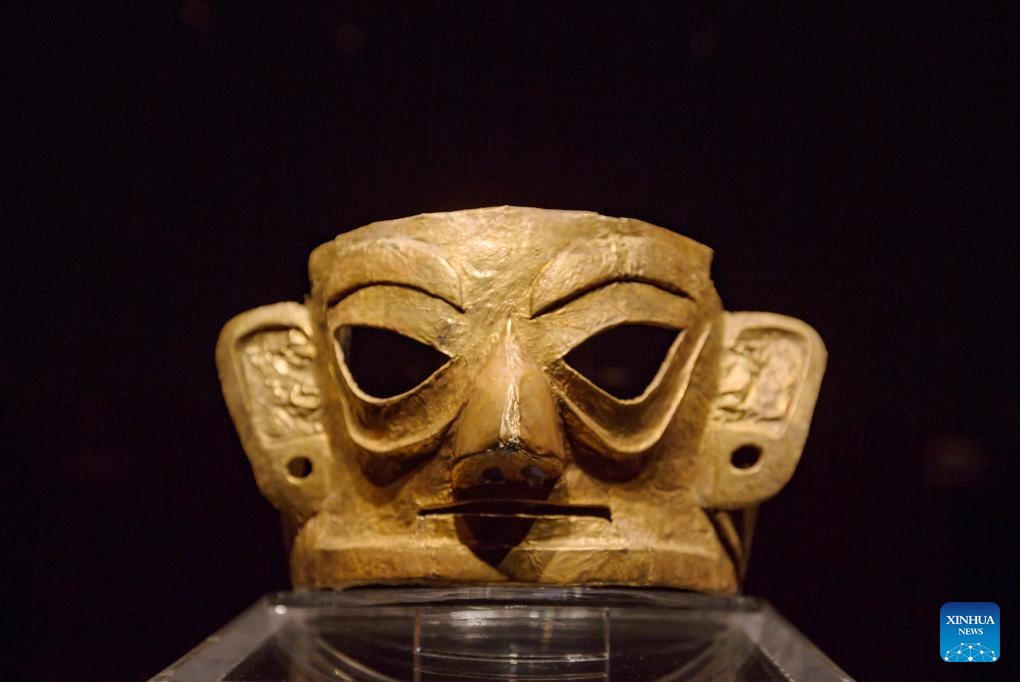
This photo taken on June 5, 2024 shows a bamboo-weaving artwork composed of a cartoon dragon pattern and a mask inspired by the renowned gold mask unearthed at the Jinsha site, at the Chongzhou culture and art center in southwest China's Sichuan Province. (Xinhua)
BEIJING, June 8 (Xinhua) -- In the Chinese popular mobile game "Honor of Kings," a character has been molded into a puppeteer, gaining acclamation from fans for its traditional beauty.
The shadow puppet gaming skin was launched earlier this week by tech giant Tencent and was inspired by Huaxian shadow plays, a main branch of the UNESCO Intangible Cultural Heritage of Chinese shadow puppetry originating from Huaxian County in Shaanxi Province in northwest China.
"In my eyes, innovative transformation with respect for tradition is the key for intangible cultural heritage to survive and thrive in the modern era," said Dang Feihua, an inheritor of the Huaxian shadow plays whose family participated in the design of the skin.
This online gaming skin is an epitome of China's creative efforts to protect and promote intangible cultural heritage among the younger generation.
Saturday marks Cultural and Natural Heritage Day in China. Around this day, more than 12,000 related events are in full swing across the country, including 9,642 offline activities, ranging from live performances to themed lectures and photography exhibitions, according to the Ministry of Culture and Tourism.
These promotion activities are aimed at enhancing the visibility of intangible cultural practices while renewing protection efforts.
Born into a shadow puppet inheritor's family in 2000, Dang in 2017 began exploring how to integrate this traditional artistry with modern elements. Dang was inspired to do so when he witnessed a performance combining projection technology and a traditional Chinese shadow puppet show, which drew enthusiastic applause at the Venice Biennale.
Part of a team featuring several young people in their 20s, Dang has designed bookmarks, earrings and hanging decorations based on puppets and runs related accounts on social media. "The impact of shadow puppetry has gone well beyond the cultural field as it allows us to connect with our roots and strengthen a sense of identity," Dang added.
This year marks the 20th anniversary of the ratification of China's entry into the Convention for the Safeguarding of the Intangible Cultural Heritage.
Figures show that by the end of 2023, China had over 100,000 intangible cultural heritage items of various levels, including 1,557 featuring on the national intangible cultural heritage list. Notably, a total of 43 items from China have been added to the UNESCO Intangible Cultural Heritage List.
At the Chongzhou culture and art center in southwest China's Sichuan Province, a bamboo-weaving artwork with a height of nearly 4 meters caught the audience's attention.
The work was composed of a cute cartoon dragon pattern and a formidable-looking mask resembling the renowned gold mask unearthed at the legendary Jinsha site. Having been on exhibition for almost 4 months, it has attracted over 700,000 visitors.
According to Jia Yanqin, one of its authors, the artwork represents an exquisite blending of Daoming bamboo strips weaving -- a national intangible cultural heritage, and the civilization of the ancient Shu Kingdom, which had its heyday around 3,000 years ago.
"The design has symbolized a new endeavor to build greater public awareness of protecting cultural heritage, both tangible and intangible," said Jia. "I hope that in the future we can employ different traditional handicrafts and iconic artifacts to make more innovative products."
Lu Yingchuan, vice minister of culture and tourism, said that China has been strengthening efforts in the systematic protection of intangible cultural heritage. Workshops and demonstration bases have been mushrooming across the country, stimulating the innovative development of various intangible cultural heritage items.
"The trendy newly-developed products have breathed new life into the ancient heritage and also wooed consumers, unleashing market demand," he said. ■

This undated photo shows a gold mask unearthed at the Jinsha site, now displayed at the Jinsha Site Museum in Chengdu, capital of southwest China's Sichuan Province. (Chengdu Jinsha Site Museum/Handout via Xinhua)



